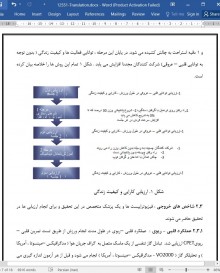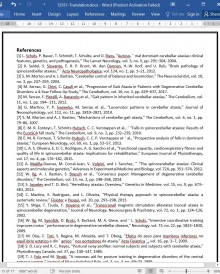
آموزش تردمیل با پشتیبانی نسبی وزن بدن در آتاکسی نخاعی – ماهیچه ای
پیش زمینه و هدف : اختلالات حرکتی مربوط به راه رفتن و تعادل تاثیر زیادی بر زندگی افراد مبتلا به آتاکسی نخاعی – ماهیچه ای SCA دارند. از این رو ، هدف این تحقیق ارزیابی احتمال آموزش مجدد راه رفتن و افزایش ظرفیت قلبی – ریوی و به چالش کشیدن تعادل در مدت راه رفتن در اختلال SCA با استفاده از پشتیبانی نسبی وزن بدن BWS و تردمیل است. همچنین، تاثیرات این نوع آموزش بر کارایی و کیفیت زندگی بررسی شده اند.
روش ها: 8 بیمارSCA در مرحله اول تحقیق حضور داشتند . در این مرحله تاکید بر آموزش راه رفتن و شرایط قلبی – عروقی است. از 8 بیمار ، 5 نفر در مرحله دوم شرکت کردند. تاکید مرحله دوم تحقیق متمرکز بر آموزش تعادل دینامیک در مدت راه رفتن است. مراحل اول و دوم به ترتیب 8 و 10 هفته طول می کشند و هر مرحله دارای جلسات 50 دقیقه ای می باشند ( دو مرتبه در هفته ).
نتایج: نتایج نشان دادند که آموزش راه رفتن با استفاده از BWS نسبی تاثیر قابل توجهی افزایش عملکرد راه رفتن – شیببه تردمیل – مدت ورزش ها و ظرفیت قلبی- ریوی در افراد مبتلا به SCA دارد. بعد از مرحله دوم ، افزایش تعادل نیز مشاهده شد.
نتیجه گیری: ترکیب آموزش راه رفتن و تمرین های چالش برانگیز در سیستم کنترل وضعیت در افراد SCA امکان پذیر است – توسط بیماران SCA پذیرفته می شود – و منجر به ایجاد تغییر در توانایی راه رفتن و تعادل می شود.
1. مقدمه
آتاکسی نخاعی-ماهیچه ای SCA در برگیرنده یک گروه اختلالات ذاتی کروموزوم غیر جنسی است که از انحطاط پیشرفتی مخچه و سیستم های مربوطه حاصل می شود (1). SCA علاوه بر انحطاط مخچه با انحطاط در سایر قسمت های سیستم عصبی همراه می شود و منجر به علائم غیر مخچه ای مثل از دست دادن بخش های هرمی و غیر هرمی می شود. این علائم در آتاکسی و سایر موارد علت شناسی رایج هستند که می توانند اختلال افراد مبتلا به SCA را وخیم تر کنند(2).
از میان اختلالات حرکتی حاصل از SCA، اختلالات مربوط به راه رفتن و تعادل از رایج ترین اختلالات هستند (3) . راه رفتن در SCA معمولا به صورت ناهماهنگ – غیر ثابت – با فاصله و بسیار متغیر توصبف می شود ( 6-4). اختلالات تعادل در SCA نیز با افزایش تاب خوردن در وضعیت و کنترل ضعیف در مدت انجام کارهای استاتیک و دینامیک توصیف می شوند (7). شایان ذکر است که اختلال در تعادل و راه رفتن در SCA ارتباط قوی با افزایش تعداد تمام موارد دارد (8.9) و این عوامل تنبلی فیزیکی را سبب می شوند و بر تناسب قلبی – تنفسی تاثیر مخرب می گذارند(10) .همه این مشکلات با هم می توانند بر تحرک ، افت سلامت عمومی تاثیر گذار باشند و عواقب فیزیکی و اجتماعی را برای این افراد به همراه دارند(7).
4.بحث
تا جایی که می دانیم این تحقیق ، اولین تحقیقی است که به بررسی کارایی و عواقب ارتباط آموزش راه رفتن و چالش های تعادل با استفاده ازPBWSTT بر فعالیت ، توانایی قلبی – ریوی و کیفیت زندگی در افراد مبتلا به SCA پرداخته است. نتایج بیان می کنند که این آموزش کاربردی است و به خوبی توسط بیماران مبتلا به SCA پذیرفته شده است. روند بهبودی بعد از آموزش راه رفتن / شرطی سازی با استفاده از PBWSTT در توانایی راه رفتن از طریق افزایش عملکرد راه رفتن و توانایی قلبی-ریوی افراد بررسی شده ، مشاهده شده است. آموزش تعادل دینامیک نیز بهبودی قابل توجه ای را در تعادل به دنبال دارد.
در پایان مرحله آموزش راه رفتن / شرطی سازی – همان طور که انتظار می رفت – بهبودی در راه رفتن از طریق اندازه گیری DGI حاصل شد. شرکت کنندگان SCA نیز می توانستند باشیببیشتر به تردمیل در دوره های طولانی تر CPET راه بروند. احتمالا، چند مکانیزم در این بهبودی ها نقش ایفا می کنند. استفاده از آموزش های فعالیت محور و افزایش سرعت می تواندد از موارد مرتبط باشند (27-25(. به علاوه، اکثر تحقیقات انجام شده در مورد PBWSTT به بررسی بهبودی در راه رفتن و تغییرات در الگوهای مرکزی در موقعیت های مختلف مثل بیماری پارکینسون – صدمات ستون فقرات – و سکته پرداخته اند ( برای مثال ، ویکلگرن 40- و میای و همکاران 41 را می توان نام برد). اگر چه اختلاف آماری بین پیک VO2 بعد و قبل از مرحله آموزش راه رفتن / شرطی سازی وجود ندارد ، اما مشاهده شده است که در 5 بیمار از 8 بیمار آزمایش شده ، افزایش پیک VO2 مشاهده شده است. این مطلب را می توان انتظار داشت زیرا آموزش تردمیل ارتباط زیادی با بهبود فعالیت قلبی-ریوی بعد از سکته در افراد دارای مشکل انسداد شریان اکلیلی دارد (43-42). به علاوه، شدت CPET برای گروه افزایش می یابد( که در مبحث شیببه تردمیل و افزایش مدتCPET نیز اشاره شده است) و بیانگر افزایش تلاش در اجرای تمرین است. می توان وجود پیک VO2 و بهبودی برگ را برای بعضی از افراد تشریح کرد.
Background and Purpose. The motor impairments related to gait and balance have a huge impact on the life of individuals with spinocerebellar ataxia (SCA). Here, the aim was to assess the possibility of retraining gait, improving cardiopulmonary capacity, and challenging balance during gait in SCA using a partial body weight support (BWS) and a treadmill. Also, the effects of this training over functionality and quality of life were investigated.
Methods. Eight SCA patients were engaged in the first stage of the study that focused on gait training and cardiovascular conditioning. From those, five took part in a second stage of the study centered on dynamic balance training during gait. The first and second stages lasted 8 and 10 weeks, respectively, both comprising sessions of 50 min (2 times per week).
Results. The results showed that gait training using partial BWS significantly increased gait performance, treadmill inclination, duration of exercise, and cardiopulmonary capacity in individuals with SCA. After the second stage, balance improvements were also found.
Conclusion. Combining gait training and challenging tasks to the postural control system in SCA individuals is viable, well tolerated by patients with SCA, and resulted in changes in capacity for walking and balance.
1. Introduction
Spinocerebellar ataxia (SCA) comprises a family of autosomal dominant inherited disorders that result from progressive degeneration of the cerebellum and its associated systems [1]. Besides cerebellar deterioration, SCA is often accompanied by degeneration of other sites of the nervous system, leading to noncerebellar signs such as pyramidal and extrapyramidal losses, which are uncommon in ataxia of other etiologies and that can worsen the impairments of people with SCA [2].
Among the motor deficits prompted by SCA, those related to gait and balance are the most common [3]. Gait in SCA is usually described as uncoordinated, unsteady, wide-based, and highly variable [4–6]. In turn, balance abnormalities in SCA are characterized by an increased postural sway and poor balance control during both static and dynamic tasks [7]. It is noteworthy that both the balance and gait impairments in SCA are strongly associated with an increased number of fall episodes [8, 9] and can favor physical inactivity, adversely affecting cardiorespiratory fitness [10]. Together, these problems can impair mobility, deteriorate general health, and yield physical and social consequences for these individuals [7].
4. Discussion
This study is the first, to our knowledge, to investigate the feasibility and consequences of the association of gait training and balance challenges using PBWSTT on functionality, cardiopulmonary capacity, and quality of life in SCA individuals. The results demonstrated that the training was feasible and well tolerated by people with SCA. Trends of improvements were found after the gait/conditioning training using PBWSTT in the capacity for walking by increasing the gait performance and the cardiopulmonary capacity of the sample of individuals studied. The dynamic balance training also brought statistically significant improvements in balance.
At the end of the gait/conditioning training stage, as expected, improvements were found in gait as measured by DGI. SCA participants were also capable of walking with higher inclination of the treadmill for longer periods of time in the CPET. Probably, several mechanisms play a role in these improvements. The use of task-oriented training and increasing the pace of effort may have been relevant [25–27]. Additionally, the majority of studies with PBWSTT attribute the gait improvements observed to changes in the central pattern generator in different conditions such as Parkinson’s disease, spinal cord injury, and stroke (e.g., Wickelgren [40] and Miyai et al. [41]). Although there was no statistical difference between the VO2 Peak after and before the gait/conditioning training stage it was observed that, in 5 of 8 participants tested, there was a VO2 Peak increment. It was expected since treadmill training has already been associated with cardiopulmonary capacity improvement after stroke and in individuals with coronary artery disease [42, 43]. Moreover, the level of intensity of CPET increased for the group (as suggested by treadmill inclination and CPET duration increments), suggesting an increased correspondent effort during its execution. It may explain the absence of VO2 Peak and Borg improvement for some individuals.
1. مقدمه
2. مواد و روش ها
2.1 شرکت کنندگان
2.2 رویکردهای مداخله ای
2.3 شاخص های خروجی
2.3.1 عملکرد قلبی – ریوی
2.3.2 توانایی فعالیت و کیفیت زندگی
2.4 آمار
3.نتایج
4.بحث
منابع
1. Introduction
2. Materials and Methods
2.1. Participants
2.2. Intervention Procedures
2.3. Outcome Measures
2.3.1. Cardiopulmonary Performance
2.3.2. Functional Capacity and Quality of Life
2.4. Statistics
3. Results
4. Discussion
References
- اصل مقاله انگلیسی با فرمت ورد (word) با قابلیت ویرایش
- ترجمه فارسی مقاله با فرمت ورد (word) با قابلیت ویرایش، بدون آرم سایت ای ترجمه
- ترجمه فارسی مقاله با فرمت pdf، بدون آرم سایت ای ترجمه



